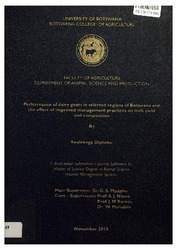| dc.description.abstract | In Botswana milk production generally come from dairy cattle breeds, but there are some goat breeds that have the genetic potential for producing large quantities of milk. This dissertation was a record of two studies on Performances of dairy goats in selected regions of Botswana and the effect of improved management practices on milk yield and composition. The first study was a survey that identified the current situation of smallholder dairy goat production in Central, Kgatleng, and Kweneng districts of Botswana. Data were collected through a survey using structured questionnaires that were administered face to face to the identified dairy goat farm owners in Central, Kgatleng, and Kweneng districts of Botswana. Data were analysed using the Statistical Package for Social Sciences software. Dairy goat production was dominated by male farmers of which the majority 75% (9/12) had less than five years experience keeping dairy goats. The common dairy goat breeds kept by farmers were the Saanen, Crosses, Toggenburg and British Alpine. All the flocks (100%) were managed in a semi-intensive production system and were estimated to produce on average of 3 kg per day milk per goat at peak of lactation. Milk yield was estimated only at peak of lactation because farmers were not regularly measuring milk yield throughout the whole lactation period, they were only using the highest milk production estimates of each goat. The major challenges that dairy goat farmers faced included lack of available breeding stock, insufficient feeds and failure of the exotic breeds to acclimatize effectively to local climatic conditions. However, farmers believed that there was potential for growth of the dairy goat industry’ through dairy goat stud breeding, and fodder production particularly lucerne and lablab forages. In an attempt to motivate farmers to venture into dairy goat production, the second study was on-station experiment that determined the effects of feeding lucerne and lablab total mixed rations (TMR) and milking frequency on milk production and milk composition of mid-lactation Saanen dairy goats managed under an intensive2. system. Twenty eight lactating Saanen goats were allocated to a 2 x 2 factorial arrangement in Randomized, Complete , Block Design for a period of seventy (70) days. Data were analysed by General Linear Model procedures in Statistical Analysis System. Goats fed the lucerne ration produced significantly higher average milk yields (2.51 ±0.067 vs 2.21 ±0.067 kg/d; P=0.0016), had higher DMl (2.49±0.067 vs 2.19±0.067 kg/d; P^0.0016) and 4% FCM (2.15±0.049 vs 1.84±0.049 kg/d; P<0.0001) than goats that were fed the lablab ration respectively. Milk yield (2.65±0.108 vs 2.10±0.108 kg/d; P<0.0001), DMI (2.60±0.107vs 2.07±0.107 kg/d; P<0.0001), 4% FCM (2.18±0.089 vs 1.81± 0.089 kg/d; P<0.0001) were significantly higher in goats that were milked twice a day than goats that were milked three times a day, respectively. Most of the farmers kept daily goats for household milk consumption with a few selling the surplus milk. Regular milking and feeding high quality total mixed rations to dairy goats increased daily flock milk yield. Therefore, local daily goat farmers should be encouraged to utilize affordable quality forages to feed their animals for increased milk production and improve their management. | en_US |

